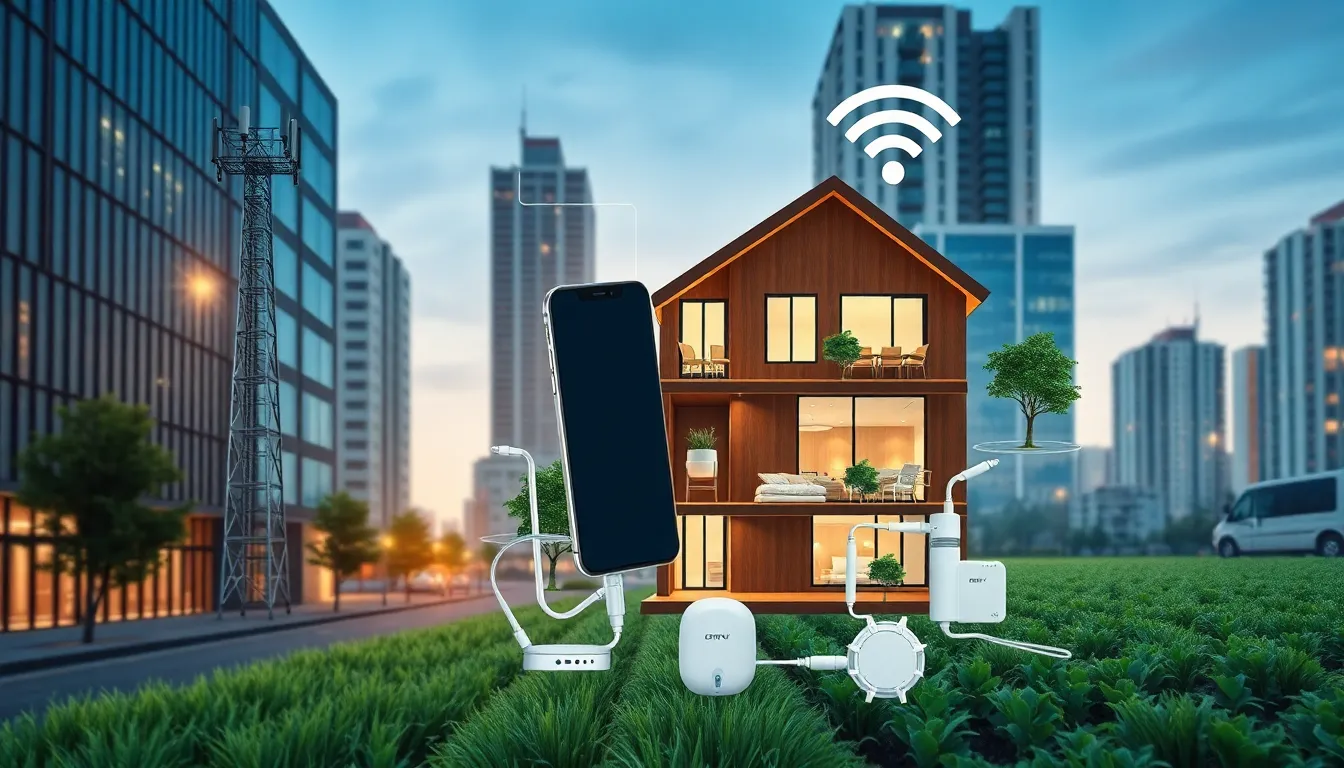In a world where your toaster might just outsmart your brain, IoT connectivity management has become the unsung hero of modern technology. Picture this: devices chatting away like old friends at a coffee shop, sharing data and insights to make life smoother. But without effective connectivity management, that friendly banter can quickly turn into a chaotic game of telephone.
Table of Contents
ToggleUnderstanding IoT Connectivity Management
IoT connectivity management plays a critical role in managing device interactions. Effective management ensures that devices communicate efficiently and securely.
What Is IoT Connectivity Management?
IoT connectivity management refers to the processes and technologies used to oversee connections between devices within the Internet of Things. This management handles device provisioning, authentication, and connectivity maintenance. It facilitates seamless data exchange across diverse networks, including cellular, Wi-Fi, and LPWAN. By developing protocols tailored to specific requirements, organizations optimize their device networks. Effective solutions enable remote monitoring and troubleshooting, enhancing overall performance.
Importance of IoT Connectivity Management
IoT connectivity management remains essential for operational efficiency. Disorganized connections can lead to data loss and security vulnerabilities. By creating stable connections, organizations protect sensitive information and ensure reliability. Management tools enhance scalability, allowing businesses to add new devices without overwhelming the system. Quick responses to connectivity issues minimize downtime and maintain service continuity. Overall, proper connectivity management contributes significantly to the success of IoT deployments, fostering innovation and growth.
Types of Connectivity in IoT

Connectivity in IoT encompasses various technologies, each suited for different applications and requirements. Understanding these types helps in selecting the right solution for specific needs.
Cellular Connectivity
Cellular connectivity relies on established mobile networks to facilitate communication between IoT devices. It ensures broad coverage, making it ideal for applications requiring mobility and remote access. With 4G and 5G networks, devices can transmit large volumes of data swiftly. Cellular connectivity supports numerous use cases, including connected vehicles and smart city infrastructure. Security is robust, with built-in encryption protocols safeguarding data during transmission.
Wi-Fi Connectivity
Wi-Fi connectivity connects IoT devices to local networks using wireless routers. Speed and reliability characterize this type, allowing devices to communicate easily within homes or offices. It accommodates high data transfer rates, making it suitable for video streaming and large file uploads. While Wi-Fi offers significant advantages, its range may restrict device connectivity, particularly in larger areas. Users often rely on Wi-Fi for smart home devices, enhancing convenience and efficiency in daily operations.
LPWAN Technologies
LPWAN (Low Power Wide Area Network) technologies enable long-range communication while consuming minimal power. Designed for devices that send small amounts of data infrequently, LPWAN is ideal for applications like smart agriculture and environmental monitoring. Several protocols, such as LoRaWAN and Sigfox, provide flexible options for organizations. These technologies excel in battery-operated devices, maximizing longevity and reducing maintenance costs. Through LPWAN, businesses can achieve wide-area coverage with fewer infrastructure investments, further enhancing scalability.
Challenges in IoT Connectivity Management
Numerous challenges exist in managing IoT connectivity effectively. These challenges can impact the efficiency and security of device interactions.
Network Security Concerns
Network security remains a top concern for IoT connectivity management. Cyber threats can compromise sensitive data and disrupt device communication. Organizations face risks like unauthorized access, data breaches, and denial-of-service attacks. Implementing robust security protocols, such as encryption and device authentication, becomes essential. Companies must stay vigilant against evolving threats while ensuring that security measures don’t hinder device performance.
Scalability Issues
Scalability presents another significant challenge in IoT connectivity management. As the number of connected devices increases, managing these connections becomes more complex. Organizations may experience performance bottlenecks or network congestion, affecting data transmission and device efficiency. To maintain seamless operations, they need to select scalable connectivity solutions. This helps accommodate growth without sacrificing quality or reliability.
Device Management Challenges
Device management challenges arise due to the diverse range of devices in the IoT ecosystem. Different devices may use varying communication protocols, complicating integration and management. Ensuring consistent updates and monitoring also poses difficulties, as organizations must keep track of device performance and vulnerabilities. Streamlining device provisioning and lifecycle management processes is crucial for maintaining efficient operations. Adopting centralized management platforms can enhance oversight and simplify operations across multiple device types.
Best Practices for Effective IoT Connectivity Management
Effective IoT connectivity management hinges on strategic choices and diligent oversight. Organizations can achieve seamless performance by following best practices in selecting connectivity types, ensuring data security, and employing monitoring techniques.
Selecting the Right Connectivity Type
Choosing the appropriate connectivity type is crucial for optimal device performance. Organizations should evaluate the specific requirements of their applications. Cellular connectivity works best for mobile devices and remote locations. In contrast, Wi-Fi delivers higher speeds suitable for smart home gadgets. LPWAN offers minimal power consumption while enabling long-range communication, making it ideal for sensor networks. By matching connectivity types to the intended use cases, businesses can enhance efficiency and reduce latency.
Ensuring Data Security
Data security remains a top priority in IoT connectivity management. Organizations must implement robust encryption protocols to safeguard sensitive information. Secure user authentication processes protect devices from unauthorized access. Regular software updates ensure devices operate with the latest security features. Additionally, employing a layered security approach mitigates risks associated with potential breaches. Establishing clear security policies creates a framework for handling vulnerabilities across the entire IoT ecosystem.
Monitoring and Analytics
Active monitoring and analytics are essential for maintaining IoT connectivity. Organizations benefit from real-time data analysis to identify performance issues promptly. Advanced analytics tools can provide insights into device operations and connectivity patterns. Companies should adopt centralized platforms for seamless visibility across multiple devices. Predictive analytics also enables proactive decision-making by forecasting connectivity needs based on usage trends. By fostering quick response capabilities, businesses can avoid disruptions and enhance overall system reliability.
Future Trends in IoT Connectivity Management
Emerging trends indicate a shift towards advanced strategies in IoT connectivity management. Key aspects include enhanced security protocols and the integration of AI and machine learning.
Enhanced Security Protocols
Growing concerns about cyber threats necessitate stronger security measures for IoT devices. Organizations prioritize the implementation of comprehensive security frameworks to protect sensitive data. By employing end-to-end encryption, businesses minimize the risk of data interception. Additionally, multi-factor authentication plays a crucial role in verifying user identities and preventing unauthorized access. Regular security audits identify vulnerabilities, allowing for timely remediation. Stronger compliance regulations also push companies to adopt best practices in securing their IoT ecosystems. These measures foster trust among users by ensuring consistent data protection and privacy.
AI and Machine Learning Integration
AI and machine learning are revolutionizing IoT connectivity management. Predictive analytics enable organizations to anticipate connectivity needs and potential failures. Real-time data analysis enhances decision-making processes, allowing for quick adjustments to network operations. Machine learning algorithms optimize device performance by learning from usage patterns. By automating routine tasks, companies can focus on strategic initiatives rather than manual monitoring. These technologies also enhance threat detection capabilities by identifying unusual patterns indicative of security breaches. Ultimately, the integration of AI and machine learning supports a more resilient and responsive IoT infrastructure.
Effective IoT connectivity management is essential for organizations looking to harness the full potential of interconnected devices. By prioritizing robust security measures and selecting the right connectivity types, they can ensure seamless communication and protect sensitive data. Embracing advanced technologies like AI and machine learning will further enhance their ability to monitor and manage devices efficiently. As the IoT landscape continues to evolve, organizations that invest in strategic connectivity management will position themselves for success, driving innovation and growth in an increasingly connected world.




